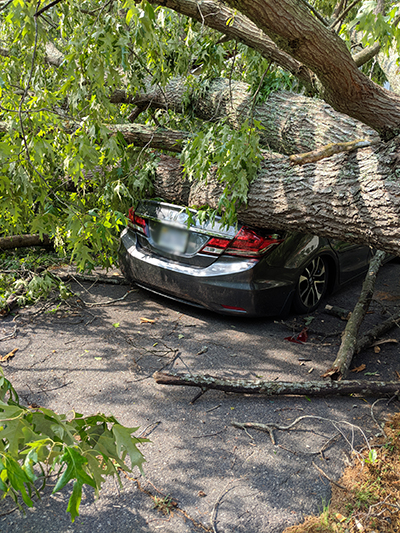Potentially Hazardous Tree on Private Property
 If the tree is on private property and threatens the public (public streets and sidewalks) submit a complaint through Fairfax County’s Planning and Land Use System (PLUS). Once a complaint is submitted in PLUS, Forest Conservation Branch (FCON) staff will assess the tree as to its degree of risk to the public once ownership is verified. If the tree is determined to be a hazard to the public, FCON will issue a health and safety code enforcement violation and require the property owner to remove the tree or part of the tree that is a hazard.
If the tree is on private property and threatens the public (public streets and sidewalks) submit a complaint through Fairfax County’s Planning and Land Use System (PLUS). Once a complaint is submitted in PLUS, Forest Conservation Branch (FCON) staff will assess the tree as to its degree of risk to the public once ownership is verified. If the tree is determined to be a hazard to the public, FCON will issue a health and safety code enforcement violation and require the property owner to remove the tree or part of the tree that is a hazard.
When a potentially hazardous tree is located on private property and is not in a position to threaten any public areas, then Fairfax County will not require the removal of the tree, but recommends that the property owner contact a private Certified Arborist or Registered Consulting Arborist for advice on how to handle the situation. Possible solutions may include pruning to remove a branch with a weak attachment or that has been weakened by decay, providing external support for weakened branches, providing remedial care, or removing the affected tree.
FCON will only inspect trees for potential impacts to the public at large and may require the property owner to remove the tree if necessary. FCON does not provide tree consulting services for property owners. If a tree is potentially threatening an overhead power line, please call Dominion Energy.
If you are considering removing a tree on your property because you have concerns about safety, it is recommended that you first obtain a determination of the level of risk from an arborist qualified as a Tree Risk Assessor. Trees provide numerous benefits to the community and add value to your property. If the tree is a low to moderate risk, removal may not be necessary. Ask your arborist what steps could be taken to reduce the risk and make your property safer without removing the entire tree. If it is determined that removal is the best way to abate the hazard, you will need to determine if the tree is located in a conservation easement or Resource Protection Area (RPA) that may be on your property.
Trees in a RPA or Conservation Easement
In general, trees that are determined to be dead, diseased and/or dying can be removed from these areas by hand, but may require replacement with similar vegetation. These restricted areas should be described in the recorded deed and may be delineated on the property plat. RPAs are also shown on county tax maps. View the Find Your Watershed map.
Consult FCON staff to review tree removal or planting, and for questions regarding RPAs or conservation easements on private property.
To request a RPA waiver, please visit the Chesapeake Bay Preservation Ordinance webpage or contact Land Development Services at 703-222-0801, TTY 711. Learn more at What Permits are Required?
To request a waiver for tree work in a Conservation Easement, contact the Forest Conservation Branch at 703-222-0801, TTY 711, or by email.